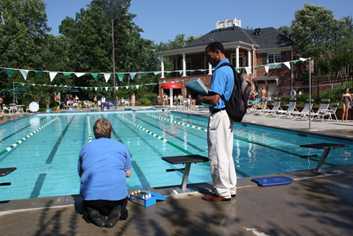Use the MAHC to Make Swimming Healthy and Safe
Print-and-Go Fact Sheet

Government agencies and the aquatics sector can use the Model Aquatic Health Code (MAHC) to make swimming and other water activities healthier and safer.
The MAHC is a free, science-based resource to improve health and safety in
- Public swimming pools
- Pools, hot tubs, and spas in hotels, apartment complexes, and neighborhoods
- Waterparks
- Other aquatic facilities
The MAHC guidelines address the design, construction, operation, maintenance, policies, and management of public aquatic facilities.
Help keep people healthy and safe by using the MAHC to reduce these health risks
- Drowning
Drowning is a leading cause of unintentional injury-related death for children ages 1–14 years 1–2. Non-fatal drowning can cause brain damage resulting in learning disabilities or even permanent loss of basic functioning 3,4. - Pool chemical injuries
Injuries linked to pool chemicals accounted for almost 3,000-5,000 emergency department visits per year (2003-2012) 5-8. Almost half of the patients were aged <18 years 5–7. - Recreational water illness outbreaks
The number of outbreaks associated with pools and other aquatic facilities has increased significantly; from an average of 15 per year (1993—2002) to 34 per year (2003—2012) 8. A single outbreak can sicken thousands 6,9. - Public pool and hot tub closings
A recent study found that 11.8% (about 1 out of 8) inspections of public pools and 15.1% (about 1 out of 7) of inspections of public hot tubs/spas resulted in immediate closure because of serious health or safety hazards 10.
How can the MAHC be used?
The MAHC is a guidance document that government agencies can use to create or update existing pool codes.
It is not a federal law and only becomes law if adopted by a state or locality. This means government agencies can
- Choose whether to adopt it at all
- Choose to use all or only certain parts
- Modify part or all of it to fit their needs
Aquatics sector leaders don’t have to wait for a government agency to adopt the MAHC. They can implement key MAHC elements now to start improving health and safety at their facilities.
Why is the MAHC important?
Swimming is one of the nation’s most popular sporting and leisure activities. People in the United States make more than 300 million trips a year to pools and other bodies of water 11, but some of these places aren’t healthy or safe. Swimming in public pools or other aquatic facilities that aren’t healthy or safe can lead to drowning, injury from pool chemicals, or waterborne illness. Using the MAHC can help make swimming healthier and safer.
What does the MAHC include?
The MAHC includes model code language (code) and scientific explanations (annex). The MAHC addresses
- Design and construction — such as secondary disinfection systems to kill chlorine-tolerant organisms and reduce outbreaks.
- Operation and maintenance — such as lifeguarding standards to reduce drowning.
- Policies and management — such as training for pool operators to reduce pool chemical accidents, pool closures, and other issues.
Check out these other sites for more information
References
- CDC. Ten leading causes of injury deaths by age group highlighting unintentional injury deaths, United States – 2010. [PDF - 1 page]
- Gilchrist J, Parker EM. Racial/ethnic disparities in fatal unintentional drowning among persons aged ≤29 Years — United States, 1999–2010. MMWR Morb Mortal Wkly Rep. 2014;63(19):421-6.
- CDC. Drowning — United States, 2005-2009. MMWR Morb Mortal Wkly Rep. 2012;61(19):344-347.
- Spack L, Gedeit R, Splaingard M, Havens PL. Failure of aggressive therapy to alter outcomes in pediatric near-drowning. Pediatr Emerg Care. 1997;13(2):98-102.
- Hlavsa MC, Robinson TJ, Collier SA, Beach MJ. Pool chemical–associated health events in public and residential settings — United States, 2003–2012, and Minnesota, 2013. MMWR Morb Mortal Wkly Rep. 2014;63(19):427-30.
- CDC. Acute illness and injury from swimming pool disinfectants and other chemicals — United States, 2002-2008. MMWR Morb Mortal Wkly Rep. 2011:60(39):1343-1347.
- CDC. Pool chemical–associated health events in public and residential settings — United States, 1983-2007. MMWR Morb Mortal Wkly Rep. 2009;58(18):489-93.
- Hlavsa MC, Roberts VA, Kahler AM, Hilborn ED, Wade TJ, Backer LC, Yoder, JS. Recreational water–associated disease outbreaks — United States, 2009–2010. MMWR Morb Mortal Wkly Rep. 2014;63(1):6-10.
- CDC. Violations identified from routine swimming pool inspections – selected states and counties, United States, 2008. MMWR Morb Mortal Wkly Rep. 2010;59(19):582-7.
- CDC. Surveillance data from public spa inspections — United States, May – September 2002. MMWR Morb Mortal Wkly Rep. 2004;53(25):553-5.
- U.S. Census Bureau. Statistical Abstract of the United States: 2012. Arts, recreation, and travel: Participation in selected sports activities 2009. [XLS - 39.5 KB] 2012.
- Page last reviewed: July 10, 2016
- Page last updated: July 10, 2016
- Content source:


 ShareCompartir
ShareCompartir
